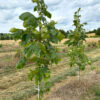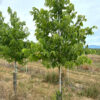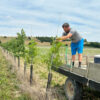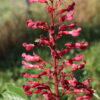
One of the most up-and-coming native trees over the past twenty years is black gum or tupelo (Nyssa sylvatica). Native to the United States east of the Mississippi River as well as the Ozark Plateau and from the southern Great Lakes and southern New England to central Florida, Nyssa sylvatica is a versatile larger tree that thrives in a broad range of conditions. Typically growing 75 to 100 ft tall in its native environment with a straight central leader and a narrow crown of right-angled branches broadening with age, tupelo generally exhibits a more moderate height of 40-50 ft in the cultivated landscape, making an excellent specimen or focal point. In the wild, it can be found on dry upland slopes and even more frequently in moist valleys and riverbottoms. In fact, the common name ‘tupelo’ is a corruption of the Muscogee/Creek Native American phrase ito ‘tree’ and opilwa ‘swamp’ or swamp-tree. In mixed-tree settings, it favors the forest edge, so it likewise prefers full sun to light partial shade in the landscape setting. Tupelo also has the

distinction of being the longest-lived non-clonal woody plant in eastern North American, with some specimens documented at more than 650 years of age.
Nyssa sylvatica starts the spring with rusty-backed, bright greenish-yellow new growth that matures to very glossy, 2”-5” long dark-green leaves. The foliage is clean and free of most pests and diseases. It is typically one of the first trees to show color at the end of the season, with the first tinges often appearing by late August. Fall foliage is a kaleidoscope of colors, from brilliant gold and fiery orange to pure scarlet and purple. In winter, the deep-grey to black bark, finely plated like alligator skin, provides a striking contrast on snowy mornings. Flowers are a inconspicuous greenish-yellow, but are nectar-rich and loved by bees; they make an excellent honey. The flowers are followed by small, blue-skinned stone fruits, usually in groups of 1-3, which are beloved by many songbirds, especially the American Robin (Turdus migratorius). Tupelo develops a strong central taproot, so plants for landscape planting are best secured from container culture or B&B nurseries that do regular root pruning, such as WHN.
As a lumber tree, the wood of Nyssa sylvatica is hard, heavy, and very durable; its cross-grain structure makes it very resistant to splitting, especially when cured. These properties made it a favored wood for early turning parts, such as pulleys, rollers, wheel hubs and weaving shuttles as well as mauls, mallets, yokes and tool handles. In fact,

its usefulness as a striking tool lead to the local common name in southeast New England of ‘beetlebung’; beetle being an old word for a mallet used to hammer home bungs or plugs for barrels of beer or liquor. Its resistance to wear and acid made it a popular flooring material for factories. Today, it is still a favored material for wood-carvers due its tight grain and resistance to splintering.

White House Natives supplies Nyssa sylvatica in a range of sizes including 1½”, 2”, 2½” and 3” caliper. It is a beautiful, clean, and disease-free tree that makes a statement in any larger landscape.





